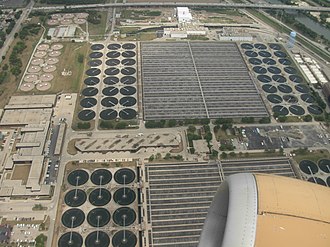Water supply and sanitation in the United States






Water supply and sanitation in the United States involves a complex interplay of public policy, private enterprise, and environmental management to provide clean drinking water and sanitation services to over 330 million Americans. The sector is characterized by its diversity, with service provision varying significantly across the country due to differences in population density, geography, water resources, and government regulations.
Overview[edit]
The United States boasts a robust infrastructure for water supply and sanitation, with the vast majority of Americans having access to high-quality potable water and wastewater treatment services. The responsibility for water supply and sanitation is decentralized, with local municipalities, county governments, and water districts playing significant roles in service provision. Additionally, the Environmental Protection Agency (EPA) sets national standards for water quality and safety through regulations such as the Safe Drinking Water Act and the Clean Water Act.
Water Supply[edit]
The water supply in the United States is sourced from a variety of means including surface water (lakes, rivers, and reservoirs) and groundwater (aquifers). The treatment and distribution of drinking water are primarily managed by local utilities. These utilities must adhere to strict quality standards to ensure the safety and reliability of the water supply. Challenges in water supply include droughts, infrastructure aging, and contamination from industrial and agricultural activities.
Sanitation and Wastewater Treatment[edit]
Sanitation and wastewater treatment in the United States are equally critical to public health and environmental protection. Wastewater treatment facilities process sewage and industrial effluents to remove contaminants before discharging the treated water back into the environment. Advanced treatment processes and technologies are employed to meet regulatory standards and protect waterways. Issues such as combined sewer overflows and sanitary sewer overflows are ongoing challenges in some regions, necessitating significant investment in infrastructure upgrades.
Regulatory Framework[edit]
The regulatory framework for water supply and sanitation in the United States is comprehensive, involving multiple layers of legislation and oversight. The Safe Drinking Water Act (SDWA) and the Clean Water Act (CWA) are the two primary federal laws governing water quality. The SDWA focuses on the quality of drinking water, while the CWA addresses pollution in surface waters. State and local governments also enact their own regulations and standards, often building upon federal requirements.
Challenges and Future Directions[edit]
The United States faces several challenges in maintaining and improving its water supply and sanitation infrastructure. These include aging infrastructure, the need for investment in new technologies, managing water scarcity in arid regions, and addressing non-point source pollution. Climate change poses additional risks, with increased frequency of extreme weather events affecting both water availability and quality.
Future directions for water supply and sanitation in the United States include investing in sustainable infrastructure, promoting water conservation and efficiency, and enhancing watershed management practices. There is also a growing emphasis on green infrastructure and low-impact development approaches to manage stormwater and reduce pollution.
Conclusion[edit]
Water supply and sanitation in the United States represent a critical yet complex component of the nation's public health and environmental stewardship. Through a combination of robust regulatory frameworks, technological innovation, and community engagement, the country continues to address the challenges of providing safe and reliable water services to its population.
Ad. Transform your life with W8MD's Budget GLP-1 injections from $75


W8MD offers a medical weight loss program to lose weight in Philadelphia. Our physician-supervised medical weight loss provides:
- Weight loss injections in NYC (generic and brand names):
- Zepbound / Mounjaro, Wegovy / Ozempic, Saxenda
- Most insurances accepted or discounted self-pay rates. We will obtain insurance prior authorizations if needed.
- Generic GLP1 weight loss injections from $75 for the starting dose.
- Also offer prescription weight loss medications including Phentermine, Qsymia, Diethylpropion, Contrave etc.
NYC weight loss doctor appointmentsNYC weight loss doctor appointments
Start your NYC weight loss journey today at our NYC medical weight loss and Philadelphia medical weight loss clinics.
- Call 718-946-5500 to lose weight in NYC or for medical weight loss in Philadelphia 215-676-2334.
- Tags:NYC medical weight loss, Philadelphia lose weight Zepbound NYC, Budget GLP1 weight loss injections, Wegovy Philadelphia, Wegovy NYC, Philadelphia medical weight loss, Brookly weight loss and Wegovy NYC
|
WikiMD's Wellness Encyclopedia |
| Let Food Be Thy Medicine Medicine Thy Food - Hippocrates |
Medical Disclaimer: WikiMD is not a substitute for professional medical advice. The information on WikiMD is provided as an information resource only, may be incorrect, outdated or misleading, and is not to be used or relied on for any diagnostic or treatment purposes. Please consult your health care provider before making any healthcare decisions or for guidance about a specific medical condition. WikiMD expressly disclaims responsibility, and shall have no liability, for any damages, loss, injury, or liability whatsoever suffered as a result of your reliance on the information contained in this site. By visiting this site you agree to the foregoing terms and conditions, which may from time to time be changed or supplemented by WikiMD. If you do not agree to the foregoing terms and conditions, you should not enter or use this site. See full disclaimer.
Credits:Most images are courtesy of Wikimedia commons, and templates, categories Wikipedia, licensed under CC BY SA or similar.
Translate this page: - East Asian
中文,
日本,
한국어,
South Asian
हिन्दी,
தமிழ்,
తెలుగు,
Urdu,
ಕನ್ನಡ,
Southeast Asian
Indonesian,
Vietnamese,
Thai,
မြန်မာဘာသာ,
বাংলা
European
español,
Deutsch,
français,
Greek,
português do Brasil,
polski,
română,
русский,
Nederlands,
norsk,
svenska,
suomi,
Italian
Middle Eastern & African
عربى,
Turkish,
Persian,
Hebrew,
Afrikaans,
isiZulu,
Kiswahili,
Other
Bulgarian,
Hungarian,
Czech,
Swedish,
മലയാളം,
मराठी,
ਪੰਜਾਬੀ,
ગુજરાતી,
Portuguese,
Ukrainian